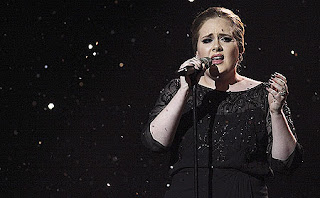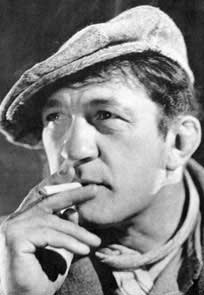 The artists of our world, Fulton J. Sheen once said, have a
special role; they often are the first to perceive—and point out—the real
problems in a society. Artists don’t necessarily offer solutions to modern
problems—but the best of them invariably identify and put before the public
exactly what those problems are. This is possible because through art man can
be brought to understand that what is evil is ugly (and, by contrast, that what
is good is beautiful), even if he intellectually is having difficulty agreeing
that what is evil is wrong.
The artists of our world, Fulton J. Sheen once said, have a
special role; they often are the first to perceive—and point out—the real
problems in a society. Artists don’t necessarily offer solutions to modern
problems—but the best of them invariably identify and put before the public
exactly what those problems are. This is possible because through art man can
be brought to understand that what is evil is ugly (and, by contrast, that what
is good is beautiful), even if he intellectually is having difficulty agreeing
that what is evil is wrong.
Lately, I’ve encountered a recent illustration of Sheen’s
point; and I may begin by recalling the name popularly attributed to our society:
“the hook-up culture.” Our world has seen no less than four decades of skewed
moral vision when it comes to romance, since the sexual revolution of the 60s. And
now, two or three generations later, the artists of our day are beginning to
point out the nasty afterbirth of the free love, hookup mentality in a very
provocative way. Modern musicians especially, often themselves deeply imbued
with popular notions of sexuality and love, are unmistakably starting to
outline the current generation’s desolate frustration and deep-seated
dissatisfaction with the hookup lifestyle--in fact, it is arguably the dominant theme of pop-music from artists who write their own songs. Years of rushing into sexual
relationships, inevitable and bitter breakups, have left their scars on them,
and it’s coming through in their music, perfectly detailing how painful “free
love” is in reality.
 One such case is probably a British pop-star that has hit
the top of the music world in the last few years: Adele. This contralto’s powerful soul-style songs, which successfully rocked the boat
of the American music world,
have led the charts for a long while now. And they are almost all depressing. With the
exception of some hopeful, committed-to-love kind of songs (like “Make You Feel
My Love”), Adele’s pieces are almost exclusively—and all of her top hits are
definitely—tortured, frustrated breakup songs. Her music plumbs human heartbreak,
exploring the whole wild and wicked scale of tangled emotions and passions:
from burning emotional desolation, to sorrowful unwillingness to let go of the
past in spite of the pain, to furious, bitter vengefulness. Invariably at the root of the anguish in
these songs is a background story of having let another soul come close in
love, of having given away oneself to another, only to have that gift and that
sort of “love” necessarily destroyed in a culture that treats relationships as
“hookups.” “Rolling in the Deep” is probably Adele’s most famous, and some fans
might balk at the idea of it’s being a mark of the hookup culture. Musically,
the piece is enjoyable, almost Diana Ross or Mo-Town style, but the lyrics
betray that the sentiment of vengeance expressed is neither a normal nor
healthy way to end any relationship:
One such case is probably a British pop-star that has hit
the top of the music world in the last few years: Adele. This contralto’s powerful soul-style songs, which successfully rocked the boat
of the American music world,
have led the charts for a long while now. And they are almost all depressing. With the
exception of some hopeful, committed-to-love kind of songs (like “Make You Feel
My Love”), Adele’s pieces are almost exclusively—and all of her top hits are
definitely—tortured, frustrated breakup songs. Her music plumbs human heartbreak,
exploring the whole wild and wicked scale of tangled emotions and passions:
from burning emotional desolation, to sorrowful unwillingness to let go of the
past in spite of the pain, to furious, bitter vengefulness. Invariably at the root of the anguish in
these songs is a background story of having let another soul come close in
love, of having given away oneself to another, only to have that gift and that
sort of “love” necessarily destroyed in a culture that treats relationships as
“hookups.” “Rolling in the Deep” is probably Adele’s most famous, and some fans
might balk at the idea of it’s being a mark of the hookup culture. Musically,
the piece is enjoyable, almost Diana Ross or Mo-Town style, but the lyrics
betray that the sentiment of vengeance expressed is neither a normal nor
healthy way to end any relationship:
See how I'll leave, with every
piece of you
Don't
underestimate the things that I will do
. . .
Baby, I have no story to be told
But I’ve heard one of you and I’m
gonna make your head burn,
. . . .
Think of me in the depths of your
despair
Making a home down there, as mine
sure won't be shared.
The message beneath the music plainly conveys a firestorm of
fury; although the source is somewhat vague in “Rolling in the Deep,” another
Adele song about heartbreak, “Set Fire To the Rain,” sheds a little light on
the situation. “Set Fire to the Rain” comes from the same album, 21, which Adele supposedly wrote about
her breakup with her lover of two years, and tells her story of passionate
“falling in love,” consequent breakup, and ends with some disturbing imagery
describing the singer’s sense of betrayal:
When I lay with
you
I could stay
there
Close my eyes
Feel you here
forever
You and me
together
Nothing is
better
. . . there's a side to you
That I never
knew, never knew,
All the things
you'd say,
They were never
true, never true,
And the games
you play
You would
always win, always win.
. . . . . .
I set fire to
the rain
And I threw us
into the flames
And I felt
something die
'Cause I knew
that that was the last time!
 Although less famous than Adele, another striking artist
rapidly rising in popularity is Ingrid Michaelson, whose music betrays at the
same time a desperate longing for fulfillment and a painful realization that
a hookup lifestyle leaves one unfulfilled. “The Way I Am,” certainly her most popular song, describes a desire for committed, faithful
love:
Although less famous than Adele, another striking artist
rapidly rising in popularity is Ingrid Michaelson, whose music betrays at the
same time a desperate longing for fulfillment and a painful realization that
a hookup lifestyle leaves one unfulfilled. “The Way I Am,” certainly her most popular song, describes a desire for committed, faithful
love:
If you were falling, I would
catch you;
You need a light, I’ll find a
match . . .
If you are chilly, here, take my
sweater;
Your head is aching, I’ll make it
better
Because . . . you take me the way
I am.
While she sings of fidelity and commitment, however,
Michaelson also recounts how scarred living a free love lifestyle can leave a
person, in her less-well-known, post-breakup song, “Starting Now”:
I want to crawl back inside my
bed of sin
I want to burn the sheets that smell like your skin
Instead I'll wash them just like kitchen rags with stains
Spinning away every piece that remains of you
But before you finally go there's one thing you should know: that I promise
Starting now I'll never know your name
Starting now I'll never feel the same
Starting now I wish you never came into my world
It's my world, it's not ours anymore.
I want to burn the sheets that smell like your skin
Instead I'll wash them just like kitchen rags with stains
Spinning away every piece that remains of you
But before you finally go there's one thing you should know: that I promise
Starting now I'll never know your name
Starting now I'll never feel the same
Starting now I wish you never came into my world
It's my world, it's not ours anymore.
There is a tangible pain and bitterness in these shocking
lines, which simultaneously describe both the hookup world and exactly what it
does to a soul: brings it to the apex of commitment, the utmost physical
indication that a total self-gift has been made, only to destroy that sense of
love and leave the heart shattered and aching in the end.
If Bishop Sheen was right, and the artists of a time are the
first to speak about the problems with a society, then modern music is a signpost
pointing unmistakably to the modern notions of love. There are others; Ingrid Michaelson and Adele
are just two of many whose work runs along similar themes. These musician’s
voices are singing some poignant truths about our world’s problems, and, while
not prophetic or profound, and whether or not they realize it, as artists they are
at least unanimously pointing to the same truth: the hookup culture hurts. It
leaves souls desperate, thirsty for fulfillment, broken, feeling betrayed and
angry. Hopefully, as the world listens to their music, it will start to listen
to their words and what they have to say about our society’s stance on love.








